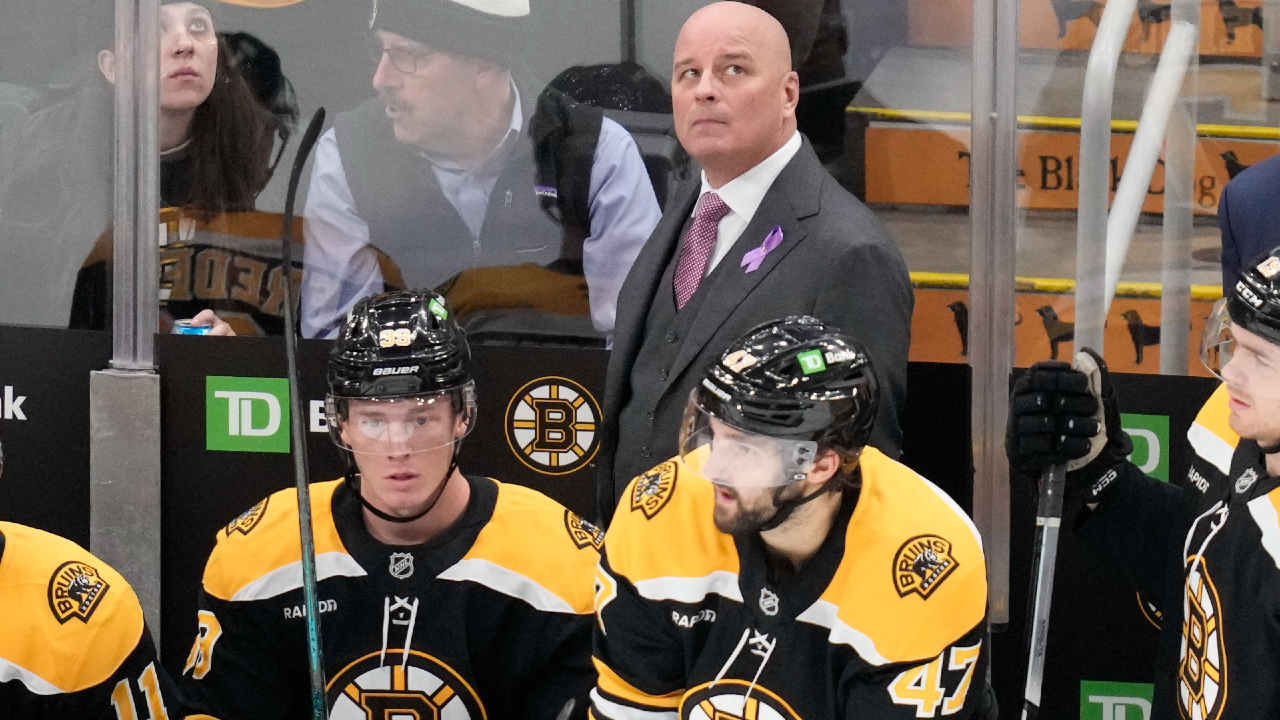Optimistic or pessimistic? Analyzing the Atlantic Division logjam
The Florida Panthers have created separation on top, while the Toronto Maple Leafs and Tampa Bay Lightning should be fine in the long run. From there, the Atlantic is a logjam of teams hoping to be in the playoff mix. Jason Bukala writes about how he’s seeing these teams early on.

The NHL’s Atlantic Division is off to a mostly pedestrian start. Outside of the Florida Panthers, who top the division with a 9-3-1 record and have won five straight games, the rest of the teams have endured some uneven play out of the gate:
• The Toronto Maple Leafs appear to be trending in a positive direction, especially with their power play finally starting to produce, as they adapt to the style new head coach Craig Berube wants the group to play. They might not win the division, but they should have no issues making the playoffs.
• The Tampa Bay Lightning have looked terrific some nights and borderline disinterested some nights. The Lightning frustrate me at times, but they have the horses (Nikita Kucherov, Brayden Point, Brandon Hagel, Victor Hedman) to outscore their warts on any given night. Jake Guentzel is still adjusting to his new team and has another level to provide and Andrei Vasilevskiy still ranks as one of the top netminders in the NHL when on top of his game. They’re behind Detroit in points percentage 13 games into the season, but bank on them being fine in the long-run.
• The Montreal Canadiens are still trying to figure out how to play with a consistent team identity. They have been riding a roller-coaster of results that have lead to a 4-7-2 record and the second-worst goals against average in the league (4.00).
The rest of the teams in the division are all packed pretty tightly, with various reasons to either be concerned or hopeful of what’s ahead. Still noting it’s early in the season, I’m trying to conclude if I should be optimistic or pessimistic about the future outlook facing the Buffalo Sabres, Detroit Red Wings, Ottawa Senators and Boston Bruins, who may end up wrestling over one playoff spot in the East (or two at most).
• The Sabres continue to be an inconsistent team that runs ice cold or lukewarm for long stretches but never seems to get hot enough to either track down teams in front of them or pull away from teams behind them in the standings.
• Their power play started the season 1-for-26 and their penalty kill has room for improvement. Their combined special team statistics (PP% plus PK%) adds to 86.6 per cent. They have to find a way to move those numbers over 100 combined.
• Buffalo is very young in goal. Ukko-Pekka Luukkonen (25) and Devon Levi (22) have been tasked with tending the crease for a team desperate to make headway. The two netminders have combined to play a total of 109 games and 34 games respectively, with Luukkonen taking over more of the starter’s workload. A lot of Buffalo’s outlook relies on stability in the crease. No pressure!
• Tage Thompson is back ripping pucks and scoring goals after a bit of a dip last season (29G-27A). He’s already contributed 8G-7A, leads the team with 44 shots, and holds the keys to improving the results for the Sabres’ power play. There aren’t too many NHL goalies who can stop Thompson’s one timers from the weak side flank on the man advantage. He doesn’t have a power play goal yet on eight shots, though.
• Owen Power, Rasmus Dahlin and Bowen Byram are leading the way defensively for Buffalo. They log the most amount of ice time and contribute offence — each of them are within the top 33 scorers at the position league-wide.
• When it comes to how the Sabres score goals, one of my concerns is the fact they aren’t a team that shows a willingness to get to the front of the net. They don’t set screens, clean up rebounds, or tip pucks enough. In short, they don’t create enough “havoc” around their opponent’s net.
Pessimistic or Optimistic?
Pessimistic: It feels to me like this is a team that will tease its fan base on occasion with some positive results — like this week’s 5-1 win over Ottawa — but they have too many inconsistencies in their lineup, they’re very young in net and haven’t shown me enough “growl” in the hard areas of the ice.
• The Wings nearly made the playoffs last season, losing out on the final wild card spot to the Washington Capitals in the tie-breaker (fewer regulation wins).
• The Wings have one of the best power plays in the NHL. Those results on the man advantage can keep them in close games and potentially lead to more victories.
• As good as Detroit’s power play is, their penalty-kill has to improve from 69.4 per cent (28th in the NHL). They have to find a way to block more shots or get a timely save when a man short.
• The Wings’ top five scorers are creating on the power play, but struggling to keep pucks out at even strength. They have combined to score 18G-31A, but are also a combined minus-3. Detroit’s overall team goal differential is also minus-3.
• Today’s NHL is a track meet every night, and the Red Wings are one of the slowest outfits in the entire league. They rank in the bottom half of the NHL in every skating metric, including top speed and small area bursts, which might explain the following chart:
Their high danger scoring chances are horrendous. They rely on scoring from distance or the perimeter slot more than most teams. They have to find a way to hunt pucks around the crease area more effectively than they are, and need to play quicker so they arrive on the scene first in all three zones.
Pessimistic or Optimistic?
Pessimistic: This group of Red Wings might get hot and find a way to ride a strong power play with their skill players, but they need to play with more grit, grizzle, and speed. The games get harder after Christmas, and I’d assume the Wings will be looking to add the type of player who will help in the areas I’m describing.
• It won’t matter how great the Senators’ win/loss record is on home ice if they don’t start to find ways to bank important points on the road. They had a chance to put some distance between themselves and the Sabres on Tuesday night and ended up on the wrong side of a 5-1 loss. Instead of waking up five points clear of Buffalo, the Senators opened up an early season window for a team below them in the standings to climb back in.
• Linus Ullmark has been average to start the season in Ottawa. Suffice to say they are banking on him stealing some games as the season rolls along.
• Conversely, Anton Forsberg has been mostly solid for the Senators and on balance has provided what the team should expect from its backup netminder.
• Tim Stutzle has been terrific for the Senators. Not only is he providing offence (6G-11A), he’s playing a more physically engaged style. Stutzle has been credited with 25 hits and eight blocked shots in his first 12 games this season, compared to 100 hits and 41 blocked shots all of last season.
• He flies under the radar compared to other young defenders on the Senators’ roster, but veteran Nick Jensen has been a stabilizing influence for Ottawa. He’s averaging over 20 minutes of ice time and being deployed in all key defensive scenarios. Jensen has contributed five assists offensively but, more importantly he leads Ottawa’s defencemen with a plus-8 rating.
Pessimistic or Optimistic?
Optimistic: Ottawa’s power play is fantastic and their penalty-kill isn’t horrific. I’m banking on Ullmark rounding into form and stealing some games on the road for them. I feel like Ottawa is playing with more structure as a team overall and could chase down a wild card spot. There will be some hiccups along the way, but they are close.
• What to make of the Bruins? They have been a powder keg to start the season. Head coach Jim Montgomery has had some animated interactions with team captain Brad Marchand and recently benched leading scorer David Pastrnak for the entire third period of their game versus Seattle.
• Boston has been up and down like a yo-yo. Their recent five-game stretch included a 2-0 loss to Philadelphia, followed by an 8-2 loss to the Carolina Hurricanes. The Bruins then rebounded with back-to-back shutout victories over Philadelphia and Seattle before being shutout by Toronto 4-0 on Tuesday night. Talk about a team that’s difficult to figure out.
• Jeremy Swayman missed all of training camp negotiating a new contract. In his first 10 games of the season as the Bruins’ undisputed No. 1 netminder he has posted a 4-5-1 record paired with a 3.14 GAA and .894 save percentage.
• Pastrnak leads the Bruins in scoring with 6G-5A, but he’s minus-5. It’s easy to see why the coach sent him a message.
• The Bruins are getting fantastic contribution from their fourth line. Linemates Mark Kastelic (3G-4A, +9) Cole Koepke (3G-4A, +10) and Johnny Beecher (2G-4A, +5) have been the Bruins’ most reliable group to start the season. Incredibly, the line averages only 12 minutes of ice time per game and produce those results.
• Lastly, take a look at how much more involved the Bruins are between the hash marks and around the crease in the offensive zone. The puck hasn’t gone in as much as they would like, but I believe they will eventually be rewarded for their commitment in the trenches.
Pessimistic or Optimistic?
Optimistic: The law of averages should take over in time. The Bruins will score more and the coach is in the ear of his top players to provide more commitment defensively. More timely saves from Swayman will help as well.





















